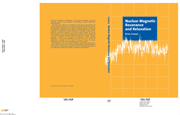Book contents
- Frontmatter
- Contents
- Preface
- 1 Introduction
- 2 Theoretical background
- 3 Detection methods
- 4 Classical view of relaxation
- 5 Quantum treatment of relaxation
- 6 Dipolar lineshape in solids
- 7 Relaxation in liquids
- 8 Some case studies
- 9 The density operator and applications
- 10 NMR imaging
- Appendix A Fourier analysis
- Appendix B Random functions
- Appendix C Interaction picture
- Appendix D Magnetic fields and canonical momentum
- Appendix E Alternative classical treatment of relaxation
- Appendix F Gm(t) for rotationally invariant systems
- Appendix G P(Ω, Ωo, t) for rotational diffusion
- Problems
- References
- Index
9 - The density operator and applications
Published online by Cambridge University Press: 02 December 2009
- Frontmatter
- Contents
- Preface
- 1 Introduction
- 2 Theoretical background
- 3 Detection methods
- 4 Classical view of relaxation
- 5 Quantum treatment of relaxation
- 6 Dipolar lineshape in solids
- 7 Relaxation in liquids
- 8 Some case studies
- 9 The density operator and applications
- 10 NMR imaging
- Appendix A Fourier analysis
- Appendix B Random functions
- Appendix C Interaction picture
- Appendix D Magnetic fields and canonical momentum
- Appendix E Alternative classical treatment of relaxation
- Appendix F Gm(t) for rotationally invariant systems
- Appendix G P(Ω, Ωo, t) for rotational diffusion
- Problems
- References
- Index
Summary
Introduction to the density operator
Motivation and definition
It is often inconvenient, for one reason or another, to keep track of all the variables of a complex system. For example, in a many-body system it would be impracticable to consider the co-ordinates of each particle. Furthermore, such information is actually not of much interest. Thus in a spin system the behaviour of the individual magnetic moments is unimportant; the components of the total magnetisation are the variables of primary interest. Very generally, for a system with ∼ 1023 co-ordinates, one is unlikely to need more than, say, ten variables to describe its observable properties. However, it is quite clear that this reduced amount of information is no longer sufficient to write down a wavefunction and, therefore, it is no longer possible to calculate the evolution of such a system using the usual methods of quantum mechanics.
In Chapter 5 we saw that it was possible, by the introduction of probabilistic arguments, to calculate the evolution of the total magnetisation of a spin system. The calculations were performed using the machinery of quantum mechanics and meaningful and useful results were thereby obtained. In this chapter we will look at things from a rather different point of view. We will not, initially, be concerned with the expectation values of certain specified observables, rather we direct our attention to the general description of the ‘state’ of the system and the way it evolves with time – possibly towards thermal equilibrium.
- Type
- Chapter
- Information
- Nuclear Magnetic Resonance and Relaxation , pp. 291 - 334Publisher: Cambridge University PressPrint publication year: 1997

